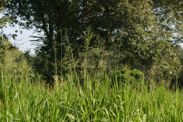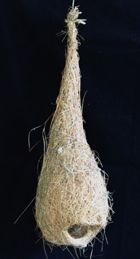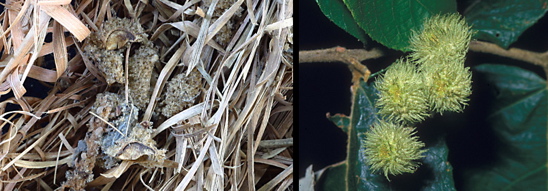Baya Weavers (Ploceus philippinus) build their nests attached to branches of trees and shrubs and even fronds of palms. These nests are expertly weaved from long thin strands of leaf blades that can come from the Guinea grass (Panicum maximum) (left), strips of palm fronds or other tough fibres – see earlier post.
A completed nest looks like an upside down flask with a downward pointing entrance chute. Within the swollen portion is the nesting area.
If the female does not approve of the construction, he will abadon it. Obviously a strong and properly constructed nest is crucial to successful breeding as otherwise the nest may fall off before the chicks fledge.
The male bird usually builds the nest half way, up to the so-called helmet stage that consists of partly of the living chamber (right). He then tries to get his mate to be interested in the half-built nest. Once he has her approval, he will continue with the construction, completing it with a tube-like structure below the entrance.
The up to a metre long neck of the nest is tightly weaved around the support, in this case the thorny stem of a bushy sensitive plant (Mimosa sp.).
Found within the neck of the nest were a few fruits, probably those of the mason bee tree (Commersonia bartramia), a common weedy tree of abandoned areas (below). Why these fruits were placed there is anybody’s guess – probably to strengthen the neck area?
The closely weaved nest (below left) needs regular repairs, as with use and the extra weight of the chicks, the neck gets overly stretched. Repairs consist of weaving in new grass materials to tighten the nest and to secure its attachment. The presence of green strands in a mostly brown nest shows evidence of such repairs, rather than recycling of the nest. Lumps of clay have also been found plastered on the inner wall of the nest, probably to stabilise the nest (below right).
 .
.
Recycling is rare, if at all, as used nests harbour the complements of parasites that the weeks of incubation and brooding brings. The nesting materials will also have been weakened through slow rotting. Generally, used nests tend to elongate as the materials get stretched through wind and rain, to eventually fall off.
Text by YC Wee, old nests provided by Tan Teo Seng.












One Response